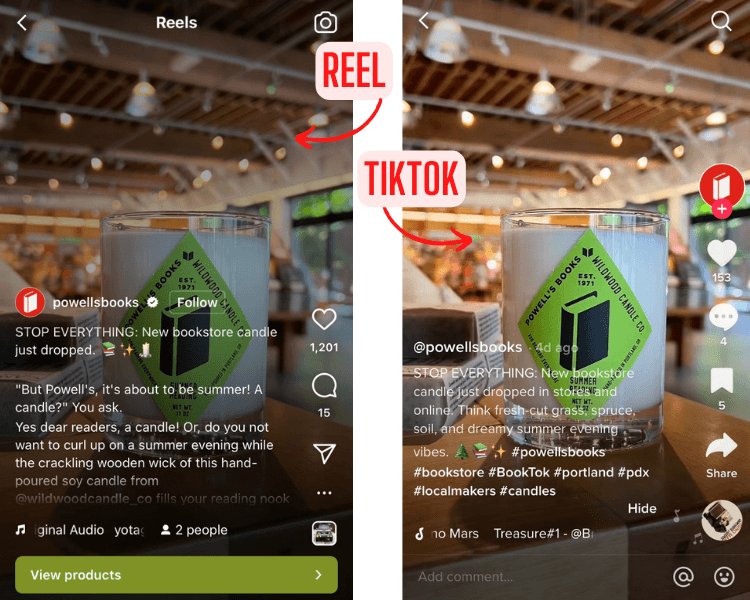Social media is one of the best ways to connect with your audiences, but keeping up with multiple social platforms takes substantial time and energy. Cross-posting, when done strategically, helps expand your reach across these platforms while saving yourself valuable time.
Ready to elevate your social media presence? Keep reading to learn:
- The answer to “what is cross-posting on social media”
- Why you might want to use it
- How to cross-post effectively
What is cross-posting?
Cross-posting on social media means repurposing the same content on multiple social media platforms. You can cross-post on two or three platforms or every platform you use. For best results, you’ll want to limit the platforms you cross-post on to the most strategic choices.
Does that mean your social profiles will be copy-paste versions of each other? Nope! While the heart of the content remains the same, the most strategic cross-posters adjust each post for the intended platform.
We’ll explore more best practices later in this post, but for now, know that cross-posting on social media can save ample time while keeping your audience’s experience in mind.
Is cross-posting a good idea?
Like any social media trick, cross-posting has pros and cons. In short, consider cross-posting if you struggle to keep up with social media’s rapid pace and want to expand your reach without dedicating substantially more time.
Pros of cross-posting on social media
To help you determine your answer to “is cross-posting a good idea,” let’s run through some of the pros of this tactic:
- Saves time: The most substantial benefit is how much time cross-posting saves you. Instead of creating all-new content for every social platform, you can reuse existing posts without diminishing your active presence.
- Maintains multiple profiles: Most brands use multiple social media profiles, and yours is probably no exception. Juggling Instagram, Facebook, and TikTok (oh my!) can be a feat. But cross-posting helps you stay consistent on all of them, even if you don’t have time to create content for all of them.
- Improves brand recognition: Because people use different social media platforms, most of your target audiences will spread across multiple platforms. Cross-posting helps you reach more people without spending extra time you don’t have.
- Creates a more memorable connection: Cross-posting on social media also helps you stay top-of-mind with those who follow you on multiple platforms. Incorporating repetition into your messaging strategy helps prospects remember your brand, creating a stronger connection.
- Acknowledges varying preferences: While one person might prefer to read a quick tweet, others might like the visual nature of Instagram. When you cross-post the same content — with appropriate adjustments — you meet these varying preferences.
- Adds fresh value to your content: You’ve created engaging content, so why not squeeze the most value you can from it? Repurposing content on multiple social media platforms helps you leverage more benefits from the same content!
Cons of cross-posting on social media
All those pros sound fantastic, right? But I’d be remiss if I didn’t mention the cons of cross-posting on social media.
The first con to consider is how different the social platforms are. Each platform has a unique set of:
- Formats
- Content lengths
- Hashtag counts
- Posting rules
For example, Twitter has the infamous 280-character post limit, and Twitter users tend to post more frequently than other platforms’ users.
You should also be careful with how repetitive your messaging gets. While some repetition can carry benefits, we all know how frustrating it can be to hear the same message repeatedly.
But if you think cross-posting will save you valuable time and elevate your social media strategy, keep reading for tips about how to do it effectively. With the right approach, you can reap the benefits while mitigating these cons.
How to cross-post on social media in 6 easy steps
Ready to learn how to cross-post on social media? Strategically using this tactic involves more than copy-pasting your content or using the automatic cross-posting features embedded in your social media apps. For best results, follow these cross-posting steps:
1. Create high-quality content
As with any digital marketing strategy, you’ll want to start with high-quality content. This value becomes more critical when you share the content on multiple platforms. If your audience will see the content numerous times, it needs to benefit them substantially.
To create high-quality social media content, consider who your target audience is. What do they value — information, humor, advice, or encouragement? Create the kind of content they like to see on social media, whether that’s beautiful photos or newsworthy information.
2. Understand each platform’s rules
As you create your top-tier social media content, you’ll also want to spend time familiarizing yourself with each platform you intend to use. Get to know each platform’s:
- Content formats
- Caption lengths
- Popular hashtags
- Hashtag limits
- Posting frequency
Keeping these variations in mind as you create your content — especially the different formats and caption lengths — will help you strategize from the beginning and create content that’ll seamlessly cross-post on two or more platforms.
3. Get to know your audience on each platform
While the technicalities of posting on each platform vary, your audience does too. The people who use TikTok and LinkedIn vary, and even when the audiences overlap, they use the different platforms for varying reasons.
TikTok gravitates towards funnier, more light-hearted content, while LinkedIn skews more professional. You can still incorporate humor into your LinkedIn posts, but it’ll likely require a different approach from your TikTok videos.
4. Determine which content types align across platforms
Now that you know the technicalities and audience variations across platforms, determine which pieces of content can work for multiple platforms. Consider both the format and tone of the content.
For example, Instagram Reels and TikToks are similar formats, so these posts offer seamless cross-posting potential. While some nuances of tone might vary between Instagram and TikTok, depending on your audience, they’re not too wildly different.
You will need to remember the varying caption lengths on these platforms, though. Instagram leaves you much more space than TikTok does for captions.
For example, Powell’s Books posted the same video on TikTok and Instagram Reels, but their Instagram caption is much longer than their TikTok caption.

5. Creatively alter your post formats to maximize your cross-posting potential
You can still cross-post even if the content formats vary more than Reels and TikToks. To do so, you’ll need to get a little more creative with your cross-posting strategy.
Take Twitter and Facebook, for example. Both platforms allow you to include text and multimedia in your posts, but Twitter requires much shorter captions than Facebook. If you have a long Facebook caption, you can still cross-post that content on Twitter.
One way you might do that is by tweeting bite-sized nuggets from your Facebook caption, with or without the multimedia. This approach could emphasize some of the key parts of your Facebook post, and it supplies you with multiple tweets.
6. Schedule your posts
Because the audiences and content vary across platforms, the posting frequency and ideal posting times also vary. To help you keep track of these differences, schedule your cross-posts.
Many social media scheduling tools allow you to schedule posts for different platforms. Need a scheduling tool to get you started? Check out our blog post with seven post schedulers you can use immediately!
Best practices for cross-posting on social media
If you follow those steps while cross-posting on social media, you should kick off this new tactic strong. To elevate your cross-posts more, keep these best practices in mind:
Choose your cross-posts strategically
Some pieces of content lend themselves to cross-posting more than others. Instead of cross-posting every social media post you create on every platform, take a strategic approach to keep your content high in value for your followers.
Create the post within each platform
Some social platforms penalize content that contains watermarks from other apps. To avoid this problem, upload your captions and multimedia to each platform individually.
Go beyond automated cross-posting in the native platforms
Many social platforms allow you to cross-post to other apps with one tap. While this approach is quick, it prevents you from adjusting the content for the new platform. Instead, consider using a scheduling tool to automate the process while tweaking the content as needed.
Measure your posts’ performance
When you measure your social media performance, you gain valuable insight into the best types of content to cross-post. For example, including multimedia with your tweets can drive higher engagement.
You can also measure which caption lengths and hashtag counts perform best on each platform.


